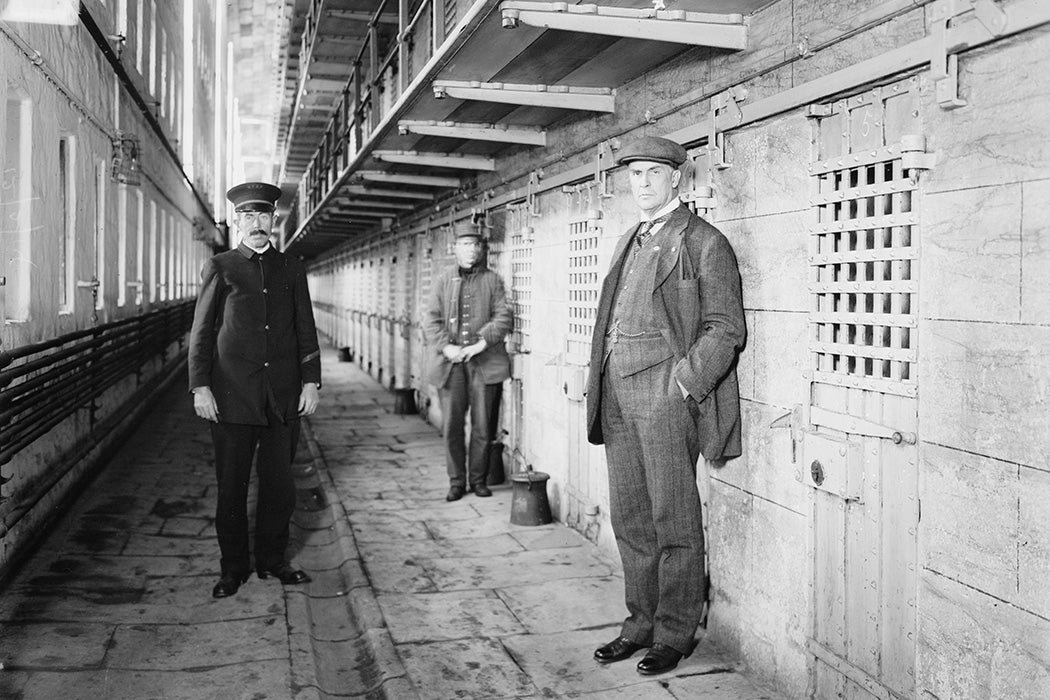The justice system of 17th and early 18th century colonial America was unrecognizable when compared with today’s. Early “jails” were often squalid, dark, and rife with disease. Cellars, underground dungeons, and rusted cages served as some of the first enclosed cells. Detention was not a form of punishment, but rather a tool of necessity while awaiting trial or transport. Because the facilities were unsecured, detainees were often kept in irons to prevent their escape. When the time for punishment arrived, it took the form of physical abuse or societal shaming. The stocks, whipping, pillory, and the ducking stool were common State responses used for lesser offenses.
If someone was found guilty of thievery a letter “T” would be branded on their hand after completing their corporal punishment. Human character at that time was perceived as permanent and immutable; a brand ensured the public would always see this person for what they were, a thief. Public hanging was the preferred punishment for a broad range of more serious offenses.
The concept of redemption came later and represented progress; it spawned the first move away from permanent punishments such as branding and execution and moved towards punishments that “targeted the soul” instead of the body. With the opportunity for redemption came “penitentiaries,” or institutions to foster penitence. The US prison system was born. According to Foucault, punishment transformed from “an art of unbearable sensations” to “an economy of suspended rights.” This shift occurred around the time of the Revolutionary War and intensified in the early 1800s.
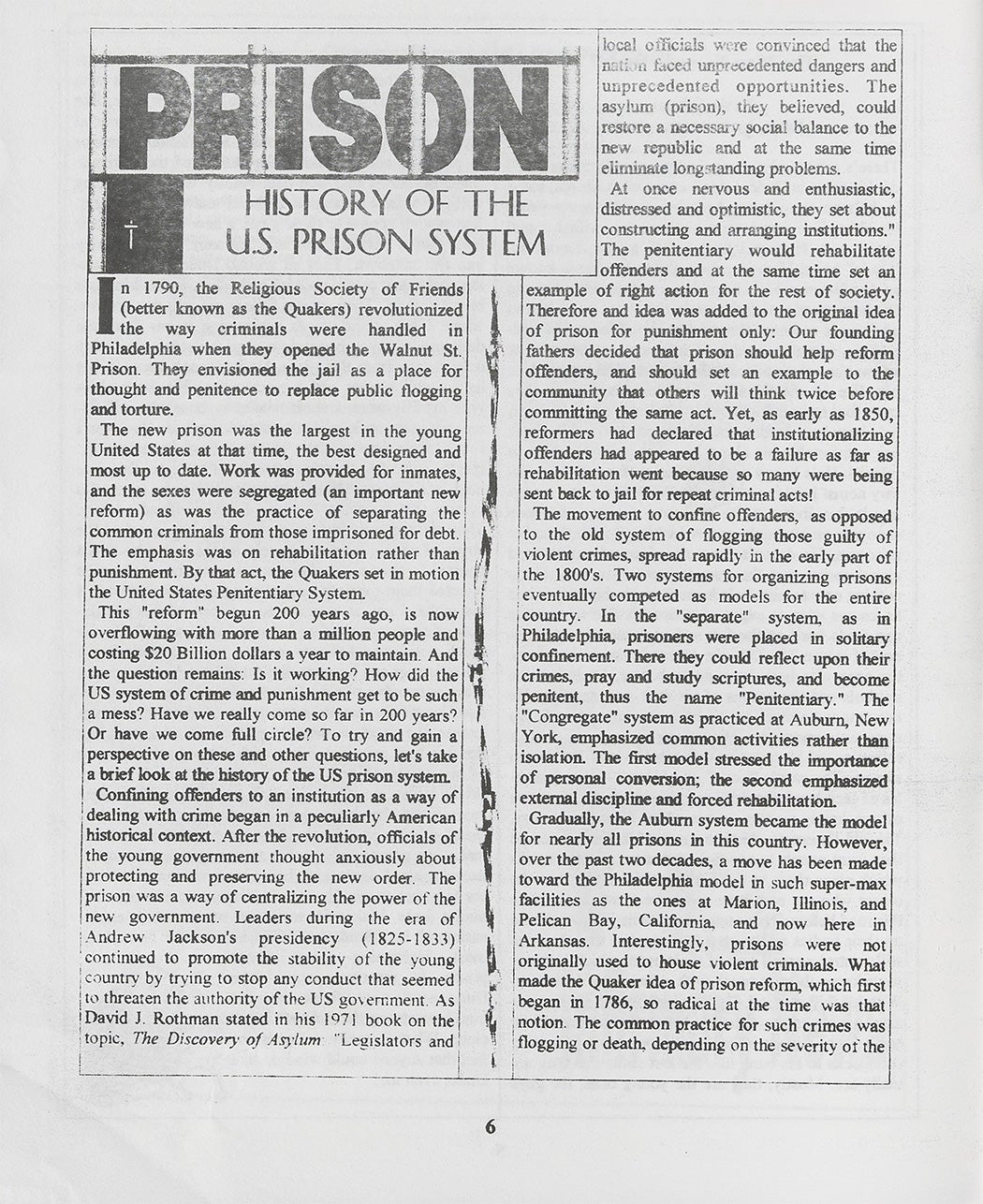
Early prisons offer case studies into the ethos of punishment in 19th century America, which marked a dramatic philosophical shift in the young republic. Opened in 1817, the Auburn Correctional Facility located in New York was hailed as a model worthy of replication, eponymously titled the “Auburn System.” It focused on so-called redemptive suffering. Auburn was a caricature of what comes to mind when thinking of early barbaric prisons: people in striped pajamas walking in lockstep, being beaten if they stepped out of line or were caught speaking to one another, and constantly forced to work hard labor in silence.
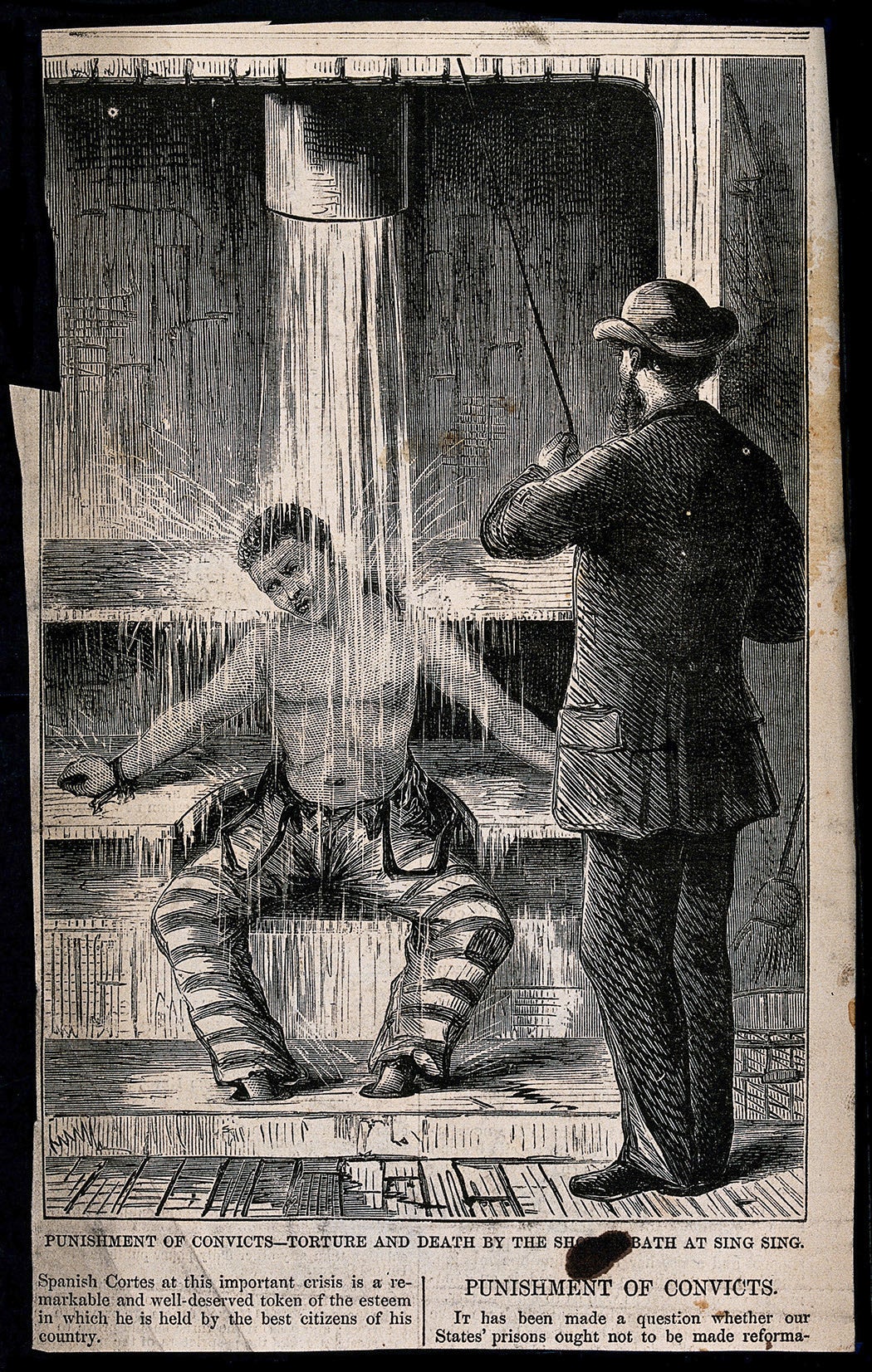
Earlier prisons were even harsher. Prior to 1821 the entire prison was composed of solitary confinement in single cells, with no communication permitted and only work suitable to be done in isolation in one’s cell. The governor of New York, upon discovering the “results so dire” those conditions had imposed, put an end to it, effectively creating the Auburn System that emphasized communal work and solitary cells for sleeping.
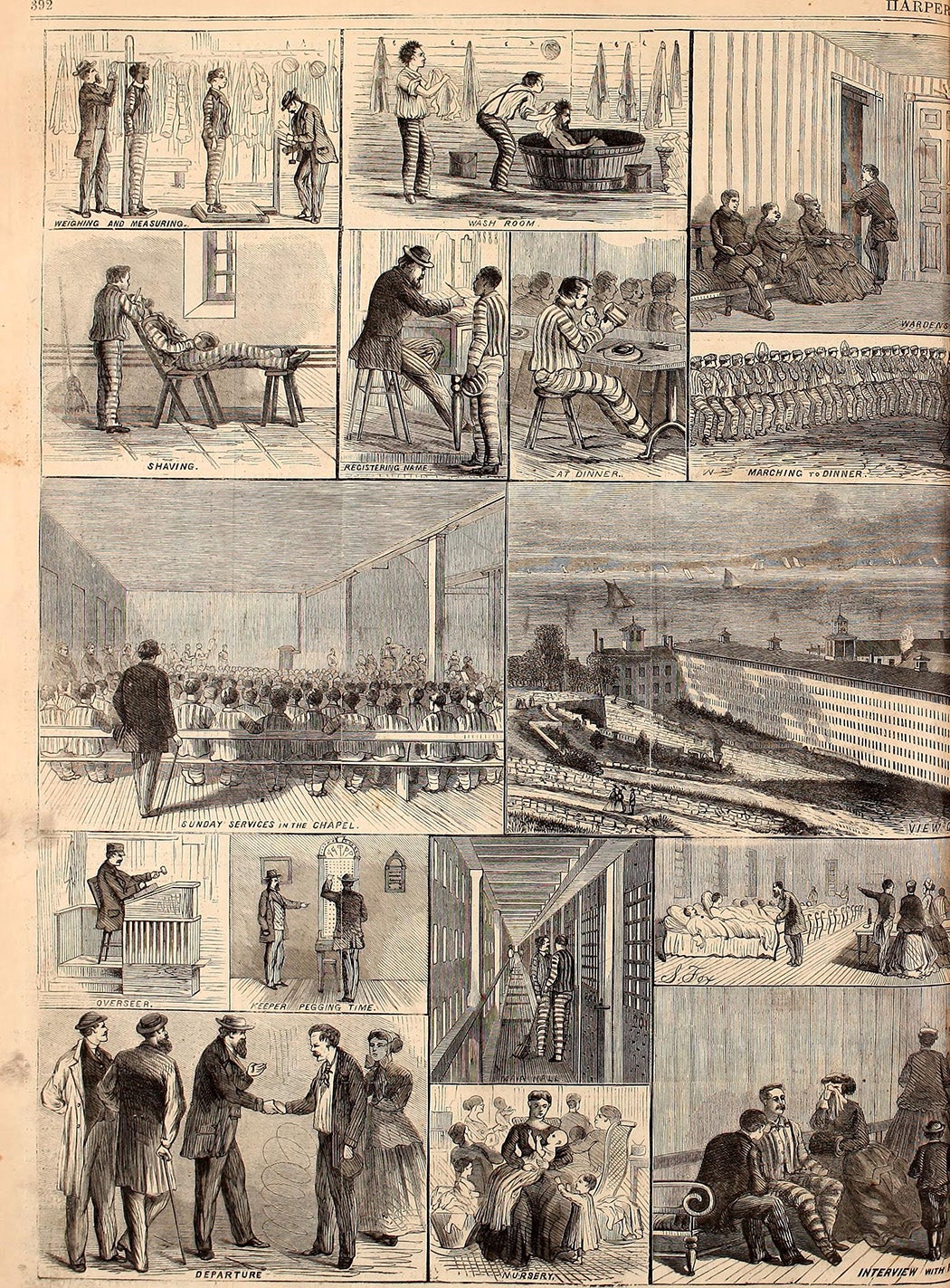
A new philosophy in corrections and political theory more broadly dictated that prisons should be economically self-sustaining. The administration desired to offset the cost of operating the prison via income-generating programs. Contracts were drawn up and “convict labor” was used to achieve cost-effectiveness, human cost notwithstanding. People incarcerated at Auburn were used to build a new prison located in New York, Sing Sing Correctional Facility.
Sing Sing, which purported to be the first facility to be constructed through “convict labor,” opened its doors in 1828. The prison adopted the Auburn System and emphasized redemptive suffering—emphasis on the suffering.

The original cells built in Sing Sing were only three feet wide and seven feet long. Cells were only used for sleeping and had no running water—indoor plumbing was rare in the United States at the time and prison was no exception. In lieu of a toilet, metal buckets inside the cells served as the receptacles for bodily functions. These buckets were dumped out just once a day. Today, indoor plumbing is not only ubiquitous but perceived as a human right, so it seems natural to assume prison cells have been updated. Unfortunately, that assumption isn’t as correct as one would think.
When I was employed by the Idaho Department of Corrections at the Idaho Maximum Security Institution, I worked in its infirmary. The infirmary was a small V shape with nine holding cells in each of the two hallways. Only two of those nine cells had running water and standard plumbing. Those toilets were flushed by a button located on the wrong side of the cell’s steel door; the person who needed their waste flushed had to ask a correctional officer to push the button for them.
Weekly Newsletter
The remaining cells of the infirmary were considered dry cells. Like the Sing Sing cells of old, they had no plumbing whatsoever. No tap water coming in, no waste going out. Their purpose ostensibly varied. In specific circumstances, restricting someone’s access to a toilet made sense on behalf of the prison administration. If the person had intentionally and repeatedly used their toilet to flood out their cell, they would go to a dry cell. Other people suspected of swallowing drugs or contraband would be placed there so their feces could be inspected, not flushed. (It is possible that today, at a prison near you, a rookie correctional officer is being told by his commander to inspect someone’s poop.) Other people—the majority—landed in them for a reason unrelated to toilet access. My questions as to why we kept so many people in cells without plumbing were never answered satisfactorily.
These holding cells consisted of a concrete room with cold walls, a steel door, and no windows in either the cells or the hallway. People placed in those cells had engaged in self-harm, attempted suicide, or were being physically combative. The cells did not give the appearance of an environment that may improve the mental health of those confined to them, and yet it was where we confined people experiencing mental health crises. In those cells, at least, correctional officers could escort people from them to the nearest cell with a toilet as needed.
That wasn’t an option in Holding Cell #9. Ominously, that one cell had looming double steel doors that blocked its entrance. The cell’s “bed” was a slab of concrete raised a few inches of the ground, barely above the grate in the floor that served as a toilet. The grate covered a hole in the floor that led to a catch-basin, effectively the toilet bowl. Much to everyone’s dismay, it usually required some smushing to get the solid waste through the grate and into the hole. Then, the person would have to get a correctional officer’s attention and request that their hole-in-the-floor be flushed. Upon a CO pressing the button, water shot out from one side of the hole and pushed (some of) the waste out. The cell perpetually stank of feces; its gray walls were lit by a bright light that never so much as dimmed.
When someone would be placed in Holding Cell #9, they would be given a smock—a green quilted robe deemed suicide-proof by officials. (It can’t be torn into strips used to hang oneself.)

If the smock-wearer should use the scratchy green material to obstruct the guard’s view into their cell or activities, the smock would be removed, and the distressed person would be left naked. Their blanket, made from the same material, would also be removed in that circumstance. Many people placed in Holding Cell #9 mentally deteriorated below the already-distressed state they had been experiencing when placed there.
One individual who spent much time in that cell stands out in my memory, for he lost his mind. Prison administrators had said he tried to commit suicide at another facility by cutting his throat and wrist. He was saved, brought to us for observation, and was placed in Holding Cell #9. As days passed, the evident sadness he was facing turned to confusion. He had no way of measuring the passage of time—time being the main metric of modern punishment. A single lightbulb kept him stirring—bright lights have been shown to disrupt natural circadian rhythm—and the only company he had was the smell of his own waste.
In the wake of September 11th, the US government adopted a series of practices derisively called “torture lite.” One of these tactics included shining bright lights on detainees. While the light of Holding Cell #9 may not be as bright, lighting is a recognized weapon in the arsenal of torture. Those tactics are traditionally reserved for people declared enemies of the state, for whatever real or imagined reason, and are utilized to get those people to “crack.” Yet in prisons, people who are already under extreme mental duress—people who have “cracked,” as we colloquially referred to it—are subjected to the same measures.
Under the dire conditions of Holding Cell #9, the incarcerated man’s confusion soon turned to agitation and then anger. He began separating his own skin, tearing out his stitches one by one. His previous suicide attempt seemed to be repeating itself. As he opened wounds, the cold walls were no longer silent. Orders by officers outside sent echoes and it shook the air around him. Before he knew it, we plastered him with oleoresin capsicum (OC) gas by an Mk9 Fogger. OC gas, commonly known as pepper spray, is used as bear repellant and is used on people attempting self-harm in prison.

The gas settled in his wounds, searing them. The pain distracted him. A cell extraction team entered in, physically subdued him, and took him to undergo the decontamination process to remove the caustic gas from his wounds, skin, eyes, and mouth. That process included being stripped naked and forcibly showered while multiple correctional officers looked on. Unbeknownst to us at that time, he would not let those wounds heal for months to come. On a weekly basis, his altered mind would force him to dig into his old wounds, prompting the same forceful response from prison staff each time. He was slowly losing his mind.
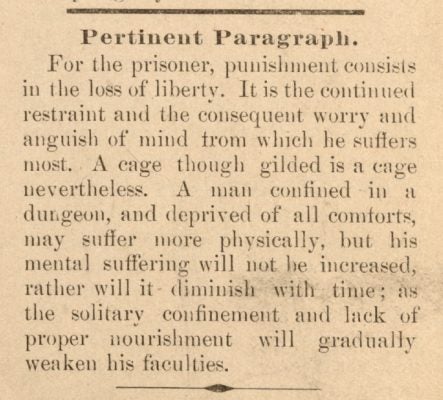
Solitary confinement has been shown to negatively affect mental health, and to do so rapidly. In fact, the damage done by isolation can be found in discourse dating back to the 19th century. Dark Cells (or ‘coolers’ as they were known in Sing Sing) were used as a means of discipline. They used them knowing it would cause mental discomfort—that was the point. Mental and physical punishment was the intended purpose of locking people in dank cells, completely isolated from other human beings. Contemporary prison administrators emphasize the penological interests of solitary confinement as a tool of maintaining order, despite persistent protestations from professionals, including the United Nations, the American Psychology Association, and judicial opinions decrying its use as inhumane, akin to torture. David Garland in the journal Social Research aggregates various schools of thought, explaining that:
Foucault’s political explanation of this change—which points to an epochal shift from a sovereign power based on violence and display to a government based on bureaucracy and discipline—is neatly complemented by Norbert Elias’s cultural explanation, which tells us that modern civilized sensibilities are embarrassed by brutish, animalistic processes and seek to minimize the barbaric signs of bodily suffering… There is a careful avoidance of any suggestion that bodily pain and physical suffering are intrinsic elements of legal punishment.
Physical suffering was inherent to early imprisonment, especially the harsh conditions of Sing Sing’s dark cells. There is alarming similarity between those and Holding Cell #9. The lighting is the main contrast: the dark cells were punishingly obscure, Holding Cell #9 is punishingly bright. While over-illumination may seem preferable to darkness, both can be construed as forms of torture. Covering the lights in any way is expressly forbidden in prison cells across the country, meaning lighting is beyond the control of the person to whom it is being subjected.
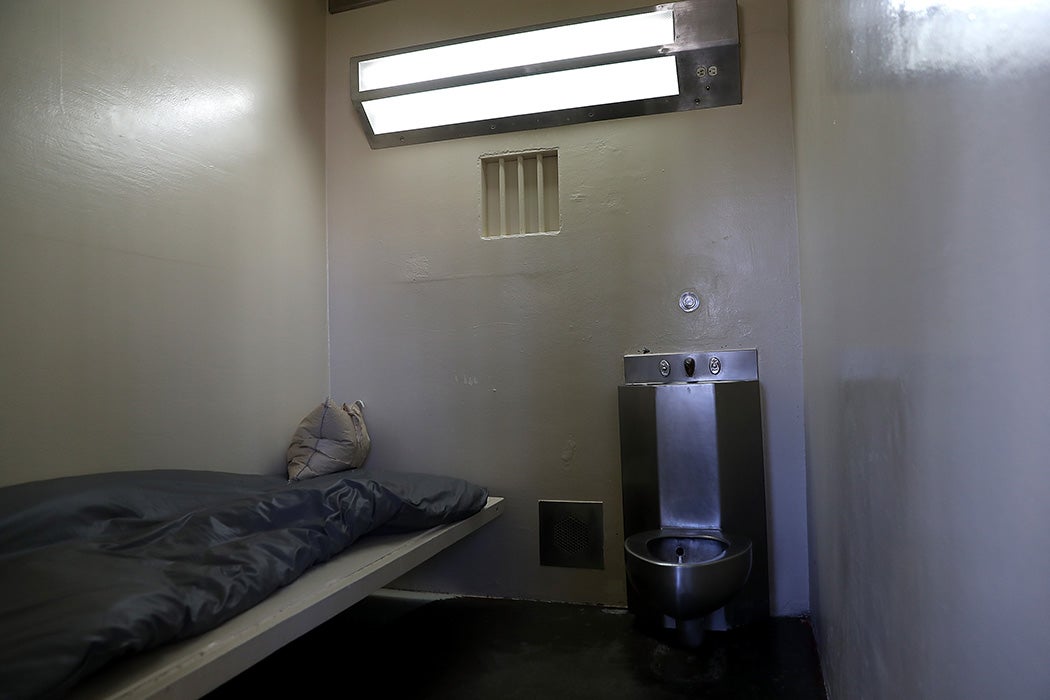
Prisons no longer purport to intentionally perpetuate suffering, but the use of solitary confinement and other harsh conditions continue. Many court decisions have held the conditions of incarceration to be “cruel and unusual punishment” in violation of the 8th amendment. The continued use of practices considered to be barbaric by psychologists and outside observers is difficult to reconcile with the sterility of the bureaucracy of justice. Garland addresses the contradiction:
The problem is that the human body is the unavoidable object of state punishment even when it is avowedly not punishment’s target …the law does not so much deny the (undeniable) bodily aspects of imprisonment. Instead, it treats them as beneath its notice, delegating them to the “realm of prison administration”—a realm that is mostly unregulated by law…
Garland asserts that the modern characterization of imprisonment as simply a “deprivation of liberty” neglects the physical elements—pain and suffering included—that are intrinsic components of US prisons.
The maximum-security prison in Idaho resolved many of the issues I described shortly after my tenure. They put toilets in the rest of those infirmary cells. Not in Holding Cell #9, though.
While the pendulum swing of corrections moves from rehabilitation to punishment and back, there has unequivocally been progress in some areas. Yet the debate about the usage of punitive measures and solitary confinement rages on, beginning in the 19th century and now spilling into the 21st. History gives us not only context for our discourse, but an inkling of an explanation as to why change may come slowly. “A long habit of not thinking a thing wrong, gives it a superficial appearance of being right,” said Thomas Paine in 1776.
